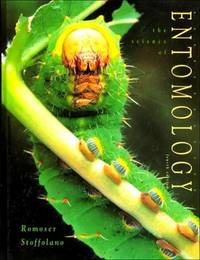Last week, I wrote about why posters should be reviewed a little more stringently than they usually are. I put out a call on Twitter for posters that people thought should have been nipped in the bud by conference organizers.
And so it was that I learned of the curious case of a 2019 Ecological Society of America poster, presented by one William S. Romoser.William Romoser died earlier this year. He was an emeritus professor of Ohio University, where he had a 45 year research career until he retired in 2010. Besides a healthy number of technical articles (many on mosquitoes), he published a major textbook on entomology that went through four editions.
I say all this because I want to stress that Romoser was the real deal. He was no crank. He has earned respect.
Yet he presented the poster below, apparently in all seriousness.
The abstract reads, in part:
To my knowledge... this is the first professional report of direct evidence of identifiable life forms beyond the confines of Earth.
You read that right. Romoser claimed to have found alien life. He claimed there were many insects and reptiles on Mars.
If this were the case, you expect you might have heard about it by now. You haven’t, so... let’s just say that Romoser did not make a compelling case.
Indeed, the idea that the discover of alien life would be announced on a poster at an ecology meeting rather than with an international press conference and coverage in Nature and Science feels absurd on the face of it.
Here is the poster.
Now, since this is a poster blog that normally focuses on design rather than content, It is frustrating that someone who had been in the game for as long as Romoser was making easily fixed mistakes.
The text is inexcusably tiny throughout. And there is a lot of it.
But back to the content. This poster appears to be a case of a common psychological phenomenon, pareidolia. It’s just ramped up to an extreme.
pareidolia (par·ei·do·lia), noun: the tendency to perceive a specific, often meaningful image in a random or ambiguous visual pattern.
Romoser is far from the first person to fall prey to pareidolia and similar over interpretations. Percival Lowell thought he saw canals on Mars, and believed they were evidence of a vast Martian civilization.
Japanese physician Chonosuke Okamura claimed to have discovered microfossils of miniature humans and other species. He was posthumously awarded an IgNobel prize for this work.
And many amateurs have claimed to see a face on Mars in blurry NASA photographs.
I completely missed this story at the time. perhaps because Romoser put a “No tweeting” icon on the poster, there seems to be not chatter about it under the #esa2019 hashtag. Romoser’s request to keep the poster off social media was ineffective, given that Ohio University initially put out a press release about Romoser’s
poster. It was soon removed. According to the university,
Romoser did not wish to interact with media.
Several people in the Twitter thread suggested that at the time this poster was presented, Remoser was experiencing some mental health issues. That is not for me to say. Regardless of why he believed that these blurry photographs were evidence of insects and snakes, it’s unfortunate that he spent so much effort on a dead end line of inquiry.
I have to agree that this is a poster that the conference organizers should have rejected. I don’t think its presentation at the meeting did anyone any favours, including Romoser.
Does Insect/Arthropod Biodiversity Extend Beyond Earth?
Mars and Earth - Partners in time? (Facebook page)
University Deletes Press Release Claiming Evidence of Bugs on Mars
It's Still Not Aliens: 'Mars Bug' Claim Could Damage the Search for Life




These research may also help different biological researchers and other scientists to rediscover other life forms that may help us look for other planets that may help people to survive when earth is already not a good place to live in.
ReplyDeleteOne Hour Device
May hut mui Batani co nen dung
ReplyDeleteTim hieu noi that phuong dong
May hut mui Batani hien nay